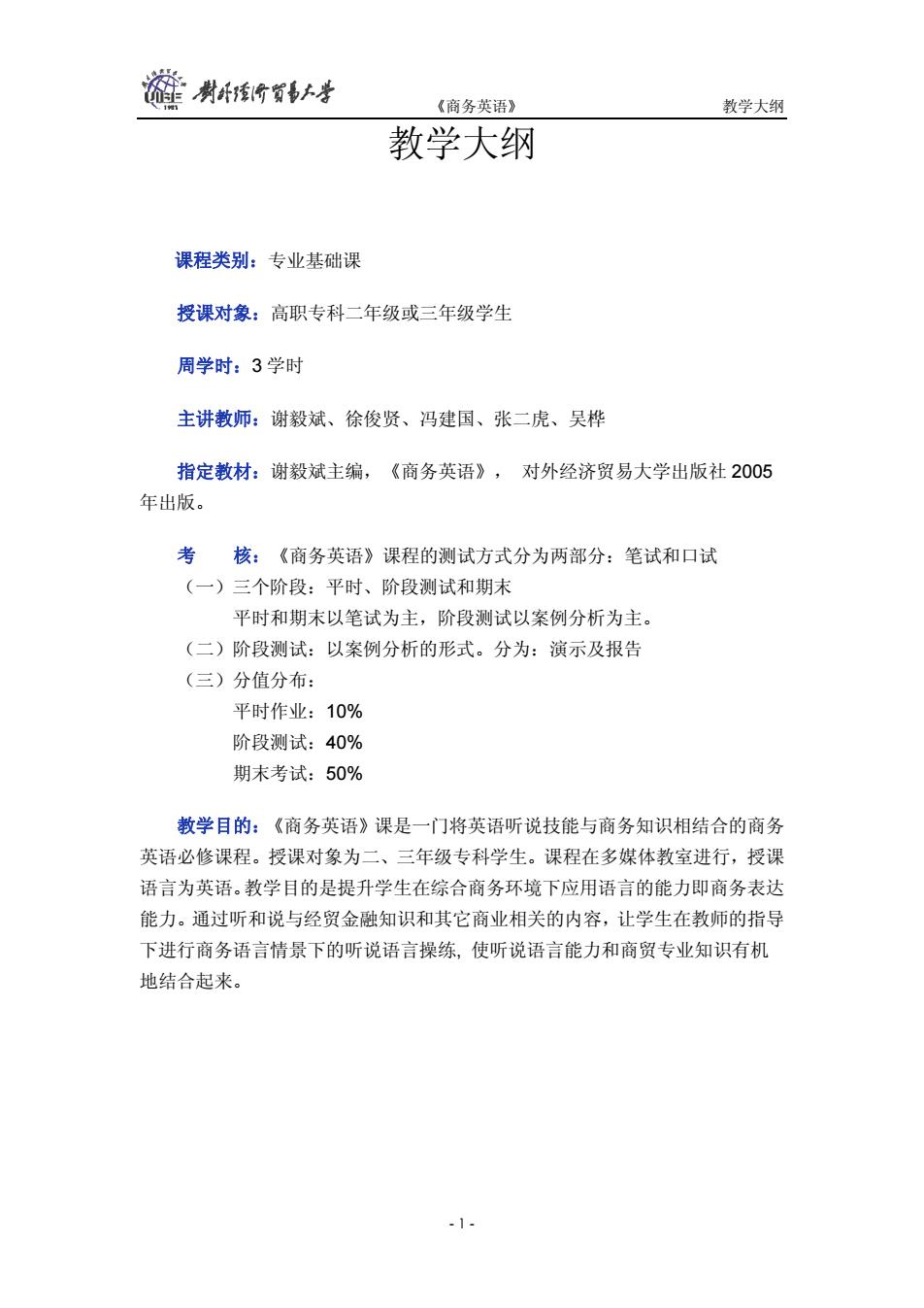
旌肉新女士 《商务英语》 教学大纲 教学大纲 课程类别:专业基础课 授课对象:高职专科二年级或三年级学生 周学时:3学时 主讲教师:谢毅斌、徐俊贤、冯建国、张二虎、吴桦 指定教材:谢毅斌主编,《商务英语》,对外经济贸易大学出版社2005 年出版。 考核:《商务英语》课程的测试方式分为两部分:笔试和口试 (一)三个阶段:平时、阶段测试和期末 平时和期末以笔试为主,阶段测试以案例分析为主。 (二)阶段测试:以案例分析的形式。分为:演示及报告 (三)分值分布: 平时作业:10% 阶段测试:40% 期末考试:50% 教学目的:《商务英语》课是一门将英语听说技能与商务知识相结合的商务 英语必修课程。授课对象为二、三年级专科学生。课程在多媒体教室进行,授课 语言为英语。教学目的是提升学生在综合商务环境下应用语言的能力即商务表达 能力。通过听和说与经贸金融知识和其它商业相关的内容,让学生在教师的指导 下进行商务语言情景下的听说语言操练,使听说语言能力和商贸专业知识有机 地结合起来。 -1-
《商务英语》 教学大纲 - 1 - 教学大纲 课程类别:专业基础课 授课对象:高职专科二年级或三年级学生 周学时:3 学时 主讲教师:谢毅斌、徐俊贤、冯建国、张二虎、吴桦 指定教材:谢毅斌主编,《商务英语》, 对外经济贸易大学出版社 2005 年出版。 考 核:《商务英语》课程的测试方式分为两部分:笔试和口试 (一)三个阶段:平时、阶段测试和期末 平时和期末以笔试为主,阶段测试以案例分析为主。 (二)阶段测试:以案例分析的形式。分为:演示及报告 (三)分值分布: 平时作业:10% 阶段测试:40% 期末考试:50% 教学目的:《商务英语》课是一门将英语听说技能与商务知识相结合的商务 英语必修课程。授课对象为二、三年级专科学生。课程在多媒体教室进行,授课 语言为英语。教学目的是提升学生在综合商务环境下应用语言的能力即商务表达 能力。通过听和说与经贸金融知识和其它商业相关的内容,让学生在教师的指导 下进行商务语言情景下的听说语言操练, 使听说语言能力和商贸专业知识有机 地结合起来
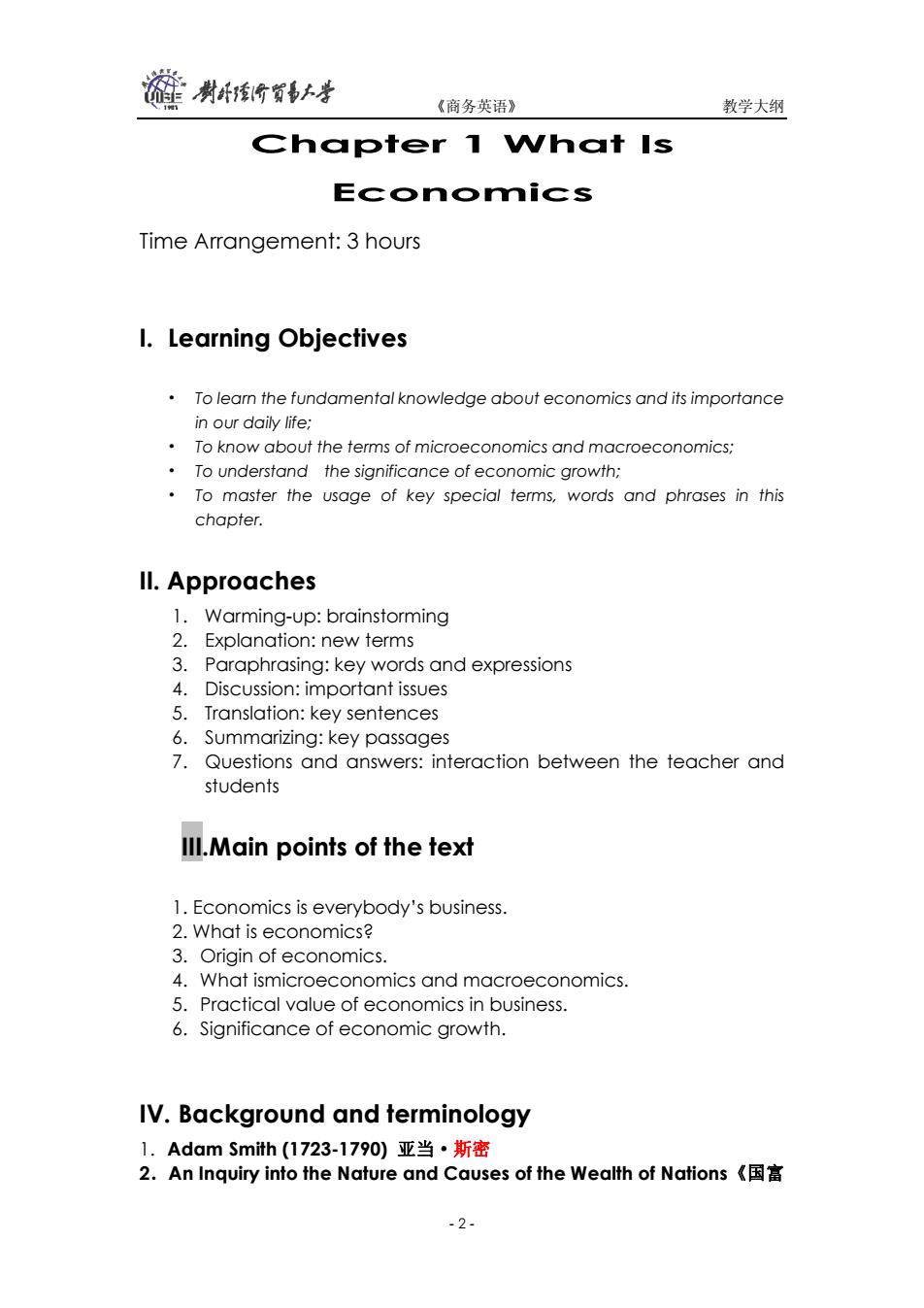
莲剥有首影上号 《商务英语》 教学大纲 Chapter 1 What Is Economics Time Arrangement:3 hours I.Learning Objectives To learn the fundamental knowledge about economics and its importance in our daily life; To know about the terms of microeconomics and macroeconomics; To understand the significance of economic growth; To master the usage of key special terms,words and phrases in this chapter. Il.Approaches 1.Warming-up:brainstorming 2.Explanation:new terms 3.Paraphrasing:key words and expressions 4.Discussion:important issues 5.Translation:key sentences 6.Summarizing:key passages 7.Questions and answers:interaction between the teacher and students Ill.Main points of the text 1.Economics is everybody's business. 2.What is economics? 3.Origin of economics. 4.What ismicroeconomics and macroeconomics. 5.Practical value of economics in business. 6.Significance of economic growth. IV.Background and terminology 1.Adam Smith(1723-1790)亚当·斯密 2.An Inquiry into the Nature and Causes of the Wealth of Nations《国富 -2-
《商务英语》 教学大纲 - 2 - Chapter 1 What Is Economics Time Arrangement: 3 hours I. Learning Objectives • To learn the fundamental knowledge about economics and its importance in our daily life; • To know about the terms of microeconomics and macroeconomics; • To understand the significance of economic growth; • To master the usage of key special terms, words and phrases in this chapter. II. Approaches 1. Warming-up: brainstorming 2. Explanation: new terms 3. Paraphrasing: key words and expressions 4. Discussion: important issues 5. Translation: key sentences 6. Summarizing: key passages 7. Questions and answers: interaction between the teacher and students III.Main points of the text 1. Economics is everybody’s business. 2. What is economics? 3. Origin of economics. 4. What ismicroeconomics and macroeconomics. 5. Practical value of economics in business. 6. Significance of economic growth. IV. Background and terminology 1. Adam Smith (1723-1790) 亚当·斯密 2.An Inquiry into the Nature and Causes of the Wealth of Nations《国富
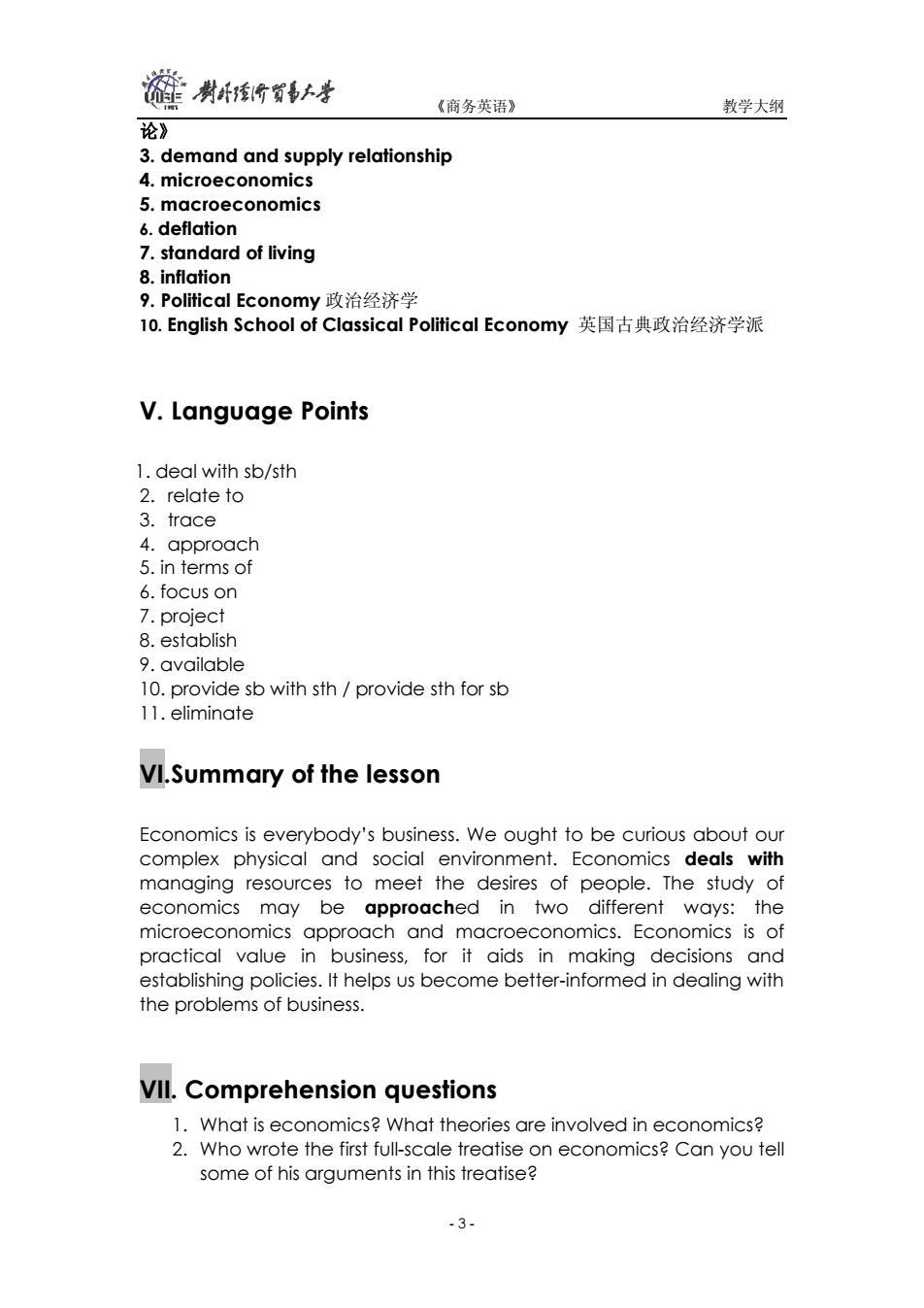
裤两乐新窗子 《商务英语》 教学大纲 论》 3.demand and supply relationship 4.microeconomics 5.macroeconomics 6.deflation 7.standard of living 8.inflation 9.Political Economy政治经济学 Io.English School of Classical Political Economy英国古典政治经济学派 V.Language Points 1.deal with sb/sth 2.relate to 3.trace 4.approach 5.in terms of 6.focus on 7.project 8.establish 9.available 10.provide sb with sth/provide sth for sb 11.eliminate VI.Summary of the lesson Economics is everybody's business.We ought to be curious about our complex physical and social environment.Economics deals with managing resources to meet the desires of people.The study of economics may be approached in two different ways:the microeconomics approach and macroeconomics.Economics is of practical value in business,for it aids in making decisions and establishing policies.It helps us become better-informed in dealing with the problems of business. VIl.Comprehension questions 1.What is economics?What theories are involved in economics? 2.Who wrote the first full-scale treatise on economics?Can you tell some of his arguments in this treatise? 3
《商务英语》 教学大纲 - 3 - 论》 3. demand and supply relationship 4. microeconomics 5. macroeconomics 6. deflation 7. standard of living 8. inflation 9. Political Economy 政治经济学 10. English School of Classical Political Economy 英国古典政治经济学派 V. Language Points 1. deal with sb/sth 2. relate to 3. trace 4. approach 5. in terms of 6. focus on 7. project 8. establish 9. available 10. provide sb with sth / provide sth for sb 11. eliminate VI.Summary of the lesson Economics is everybody’s business. We ought to be curious about our complex physical and social environment. Economics deals with managing resources to meet the desires of people. The study of economics may be approached in two different ways: the microeconomics approach and macroeconomics. Economics is of practical value in business, for it aids in making decisions and establishing policies. It helps us become better-informed in dealing with the problems of business. VII. Comprehension questions 1. What is economics? What theories are involved in economics? 2. Who wrote the first full-scale treatise on economics? Can you tell some of his arguments in this treatise?
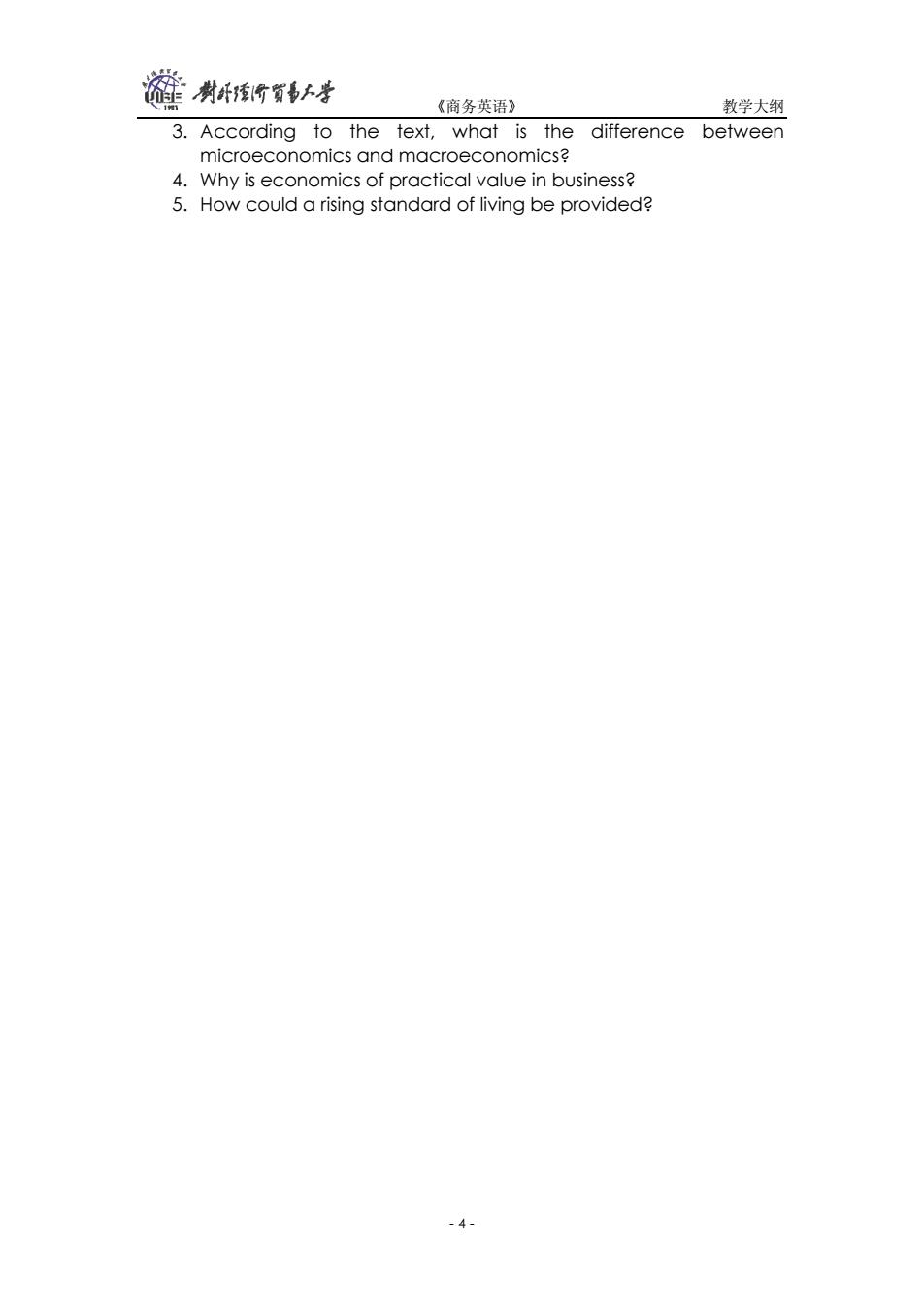
莲尉仟预有省影上号 《商务英语》 教学大纲 3.According to the text,what is the difference between microeconomics and macroeconomics? 4.Why is economics of practical value in business? 5.How could a rising standard of living be provided? -4-
《商务英语》 教学大纲 - 4 - 3. According to the text, what is the difference between microeconomics and macroeconomics? 4. Why is economics of practical value in business? 5. How could a rising standard of living be provided?
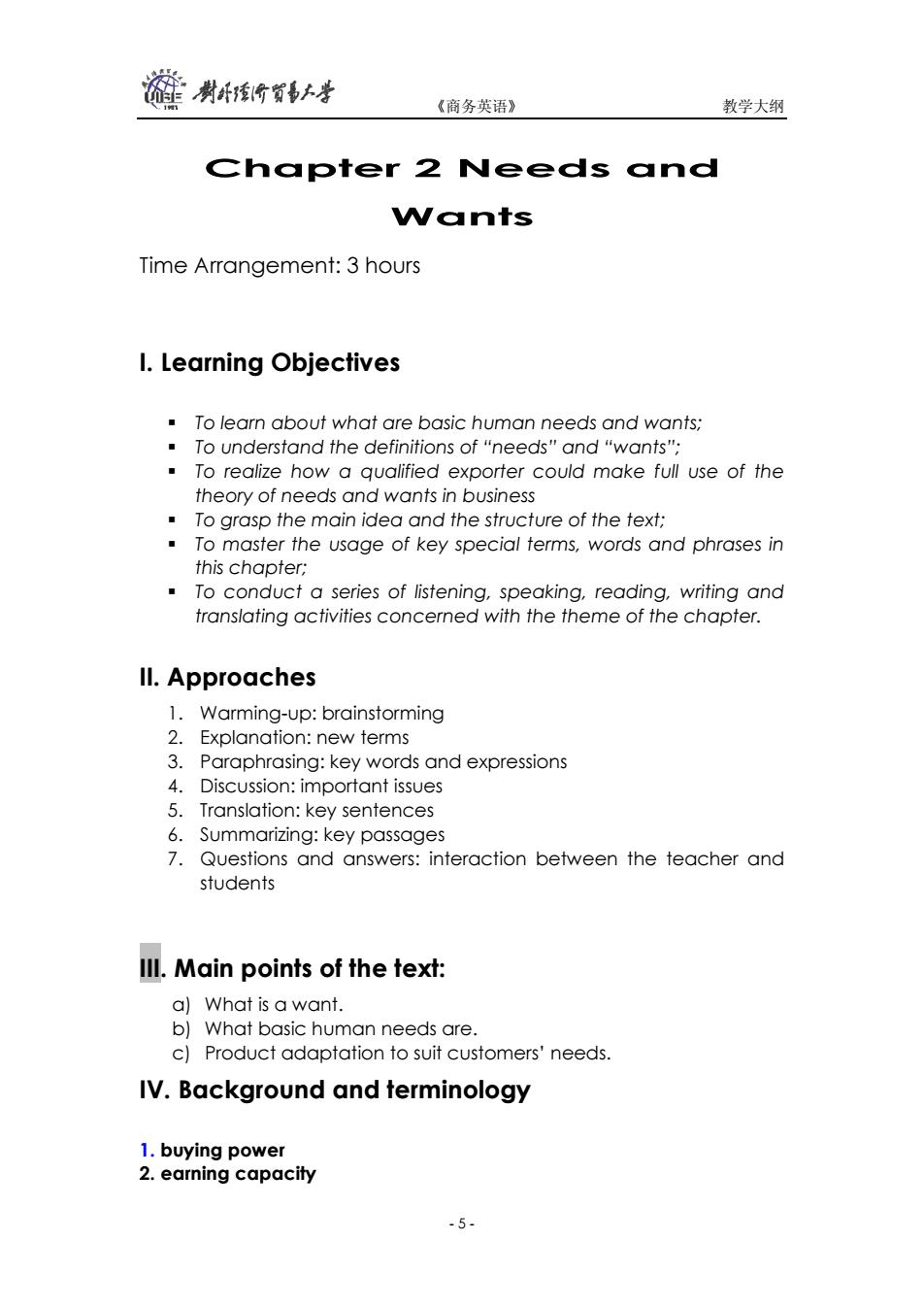
旌黄有寸 《商务英语》 教学大纲 Chapter 2 Needs and Wants Time Arrangement:3 hours I.Learning Objectives To learn about what are basic human needs and wants; ·To understand the definitions of“needs'"and“wants": To realize how a qualified exporter could make full use of the theory of needs and wants in business To grasp the main idea and the structure of the text; To master the usage of key special terms,words and phrases in this chapter; To conduct a series of listening,speaking,reading,writing and translating activities concerned with the theme of the chapter. ll.Approaches 1.Warming-up:brainstorming 2.Explanation:new terms 3.Paraphrasing:key words and expressions 4.Discussion:important issues 5.Translation:key sentences 6. Summarizing:key passages 7. Questions and answers:interaction between the teacher and students Ill.Main points of the text: a)What is a want. b)What basic human needs are. c)Product adaptation to suit customers'needs. IV.Background and terminology 1.buying power 2.earning capacity -5-
《商务英语》 教学大纲 - 5 - Chapter 2 Needs and Wants Time Arrangement: 3 hours I. Learning Objectives To learn about what are basic human needs and wants; To understand the definitions of “needs” and “wants”; To realize how a qualified exporter could make full use of the theory of needs and wants in business To grasp the main idea and the structure of the text; To master the usage of key special terms, words and phrases in this chapter; To conduct a series of listening, speaking, reading, writing and translating activities concerned with the theme of the chapter. II. Approaches 1. Warming-up: brainstorming 2. Explanation: new terms 3. Paraphrasing: key words and expressions 4. Discussion: important issues 5. Translation: key sentences 6. Summarizing: key passages 7. Questions and answers: interaction between the teacher and students III. Main points of the text: a) What is a want. b) What basic human needs are. c) Product adaptation to suit customers’ needs. IV. Background and terminology 1. buying power 2. earning capacity